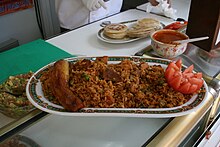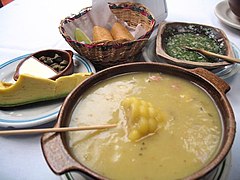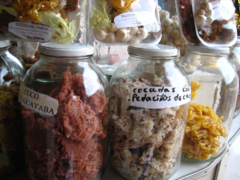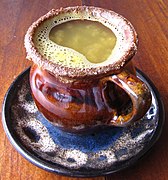Colombian cuisine
This article needs additional citations for verification. (December 2014) |

Colombian cuisine includes the cooking traditions and practices of Colombia's Caribbean shoreline, Pacific coast, mountains, jungle, and ranchlands. Colombian cuisine varies regionally and is influenced by the indigenous Chibcha, Spanish, African, Arab and some Asian cuisines.[1][2] Colombia is also one of the world's largest consumers of fruit juices (more than three quarters of a cup each day). [3]
| Part of a series on the |
| Culture of Colombia |
|---|
 |
| Society |
| Topics |
| Symbols |
Regional cuisines


Colombia's varied cuisine is influenced by its diverse fauna and flora as well as the cultural traditions of the ethnic groups. Colombian dishes and ingredients vary widely by region. Some of the most common ingredients are: cereals such as rice and maize; tubers such as potato and cassava; assorted legumes; meats, including beef, chicken, pork and goat; fish; and seafood. Colombia cuisine also features a variety of tropical fruits such as cape gooseberry, feijoa, arazá, dragon fruit, mangostino, granadilla, papaya, guava, blackberry, lulo, soursop and passionfruit.[4][5]
Among the most representative appetizers and soups are patacones (fried green plantains), sancocho de gallina (chicken soup with root vegetables) and ajiaco (potato and corn soup). Representative snacks and breads are pandebono, arepas (corn cakes), aborrajados (fried sweet plantains with cheese), torta de choclo, empanadas and almojábanas. Representative main courses are bandeja paisa, lechona tolimense, mamona, tamales and fish dishes (such as arroz de lisa), especially in coastal regions where suero, costeño cheese, kibbeh and carimañolas are also eaten. Representative side dishes are papas criollas al horno (roasted Andean potatoes), papas chorreadas (potatoes with cheese) and arroz con coco (coconut rice). Organic food is a current trend in big cities, although in general across the country the fruits and veggies are very natural and fresh.[6]
Representative desserts are buñuelos, natillas, torta Maria Luisa, bocadillo made of guayaba (guava jelly), cocadas (coconut balls), casquitos de guayaba (candied guava peels), torta de natas, obleas, flan de arequipe, roscón, milhoja, and the tres leches cake (a sponge cake soaked in milk, covered in whipped cream, then served with condensed milk). Typical sauces (salsas) are hogao (tomato and onion sauce) and Colombian-style ají.[7]
Some representative beverages are coffee (Tinto), champús, cholado, lulada, avena colombiana, sugarcane juice, aguapanela, aguardiente, hot chocolate and fresh fruit juices (often made with sugar and water or milk).[8]
There is a large variety of dishes that take into account the difference in regional climates. For example:
- In the city of Medellín, the typical dish is the bandeja paisa. It includes beans, rice, ground meat or carne asada, chorizo, fried egg, arepa, and chicharrón. It is usually accompanied by avocado, tomato, and special sauces.
- In the city of Cali, the most traditional dish is "sancocho de gallina" - a soup composed mostly of chicken, plantain, corn, coriander, yuca root, and other seasonings.
- In Bogotá and the Andean region, ajiaco is the traditional dish. It is also a type of soup made of chicken, potatoes, and flavoured with a locally grown herb called "guasca".
- In the Caribbean coast, spicy cooking, with fish and lobster, is practiced. Coconut rice is a common dish along the coastal cities.
- In the Llanos, meat from the barbecue, such as the "ternera llanera" is common, and also typical river fishes like the "amarillo".
- In the Amazonas, the cuisine is influenced by Brazilian and Peruvian traditions.
Inland, the dishes reflect the mix of cultures, inherited mainly from Amerindian and European cuisine, and the produce of the land mainly agriculture, cattle, river fishing, and other animals' raising. Such is the case of the sancocho soup in Valledupar, the arepas (a corn based bread-like patty). Local species of animals like the guaratinaja, part of the wayuu Amerindian culture.
- In the Tolima region, the Tamales Tolimenses are a delicacy. These tamales are made of a corn dough and feature peas, carrots, potatoes, rice, chicken, pork, and various spices. They are wrapped in plantain leaves and boiled for three to four hours. Pandebono for breakfast with hot chocolate.
- On the Islands of San Andres, Providencia, and Santa Catalina, the main dish is rondon, a seafood dish made of coconut milk, fish, conch, cassava root (yuca), sweet potato, white yams, and pumpkin seasoned with chili peppers and herbs. They also have a crab soup which is considered a delicacy. It is made with the same ingredients as rondon, without the fish.
- Ají picante, a spicy, cilantro-based sauce, is used as a condiment for many dishes and sides, including empanadas, platacones, and soups. This traditional sauce is from the department of Antioquia,
Piqueteaderos are rustic eateries that serve a variety of fried foods and specialties in platters for sharings. Offerings can even include huesos cerdos (pig bones), tarta de seso (brain pie) as well as fried dishes, morcilla, corn on the cob, and other Colombian delicacies.
Dishes and foods
Appetizers and side dishes

- Aborrajado (deep fried plantains stuffed with cheese)
- Arroz con coco, rice with coconut milk
- Hormigas culonas (roasted ants) a santandereanas (food from Colombia's Santander Department)
- Butifarras soledeñas, Soledeña sausage (sausage from Soledad, Atlántico)
- Carimañola, yuca fritter stuffed with ground meat, onion and seasonings
- Chunchullo, intestine
- Hogao (Criollo sauce)
- Queso blanco (white cheese) also referred to as queso fresco
- Suero, a topping similar to sour cream
- Patacones
Breads


- Almojábana
- Arepas
- Bollos (tubes of ground maize -similar to Italian polenta- or from scratched mandioc -yuca-, served with coastal cheese and sometimes whey or butter)
- Buñuelos
- Achira biscuits
- Carimañolas (like empanadas but made up of manioc)
- Colombina (lollipop)
- Curd biscuits
- Empanadas
- Garullas (corn bread roll)
- Pan de sagú (sago bread)
- Pandebono
- Pan de Maíz (cornbread)
- Pan de queso
- Pan de yuca (baked cheese bread made with yuca flour)
- Roscón (a soft and sweet bagel filled with either dulce de leche or guava jam)
Varieties of arepa


- Arepa Boyacense
- Arepa de arroz
- Arepas de huevo
- Arepa de maiz
- Arepa de queso
- Arepa de yuca
- Arepa ocañera
- Arepa Paisa/Antioqueña
- Arepa Santandereana
- Arepa Valluna
- Arepas de choclo (sweet corn)
- Brown rice and sesame seed arepa
- 'Oreja de perro', rice arepas
Fruit

Fruit and juice stands are found across Colombia, particularly on the Caribbean coast. Being a tropical country, Colombia produces a large variety of fruits, such as:
- Aiphanes horrida (corozo)
- Bactris gasipaes, peach-palm (chontaduro)
- Banana passionfruit (curuba)
- Banana (banano)
- Borojoa patinoi (borojó)
- Carambola, starfruit (carambolo)
- Cherimoya (chirimoya)
- Feijoa, Pineapple guava
- Guayabamanzana, Guava-apple hybrid
- Inga edulis, ice-cream-bean (guama)
- Manilkara huberi (níspero)
- Lulo (Naranjilla)
- Mamey sapote (mamey)
- Mamoncillo, Spanish lime
- Mandarin orange (mandarina)
- Mango
- Murrapos, mini-bananas
- Orange (naranja)
- Passiflora edulis, passion fruit (maracuyá)
- Physalis peruviana, Cape gooseberry (uchuva)
- Piñuela
- Pitaya, Dragon fruit (pitahaya)
- Quararibea cordata (zapote)
- Rubus glaucus, similar to blackberry (mora)
- Soursop (guanábana)
- Strawberry guava (arazá)
- Strawberry (fresa)
- Sugar-apple (anón)
- Sweet granadilla (granadilla)
- Syzygium jambos, Malabar plum (pomarrosa)
- Tree tomato, tamarillo (tomate de árbol)
Native fruit

Colombia is home to numerous tropical fruits that are rarely found elsewhere. Several varieties of banana include a very small, sweet version. Other Colombian fruits include zapote (Quararibea cordata), nispero (Manilkara zapota) lulo (Solanum quitoense), uchuva (Physalis peruviana), passion fruit, borojó (Borojoa patinoi), curuba (Passiflora tarminiana), mamoncillo (Melicoccus bijugatus), guanábana (Annona muricata), guava (Psidium guajava), tomate de arbol (tamarillo), noni (Morinda citrifolia). More widespread fruit varieties grown in Colombia include mango, apple, pear, blackberry, and strawberry.
Main courses

- Ajiaco
- Asado Bogotano
- Bandeja Paisa, a traditional dish from the Paisa region, consists of white rice, red beans, ground beef, plantain, chorizo, morcilla, chicharron, arepa, avocado and a fried egg. Along with Ajiaco, the bandeja paisa is considered to be one of the national dishes.
- Changua, a milk soup with or without a poached egg, usually a breakfast dish.
- Cuchuco, a thick soup made of wheat, fava beans, potatoes, ribs, peas, from Boyacá.
- Lechona, traditional dish from the Tolima department, a mixture of yellow pea purée and pork meat, with a side of rice arepa 'oreja de perro' and corn 'insulzo'
- Mondongo, a thick tripe soup.
- Picada Colombiano, chopped specialties served as a combo platter.
- Sancocho, is a popular soup originating from the Valle del Cauca region. It combines vegetables and poultry or fish with recipes differing from one region to the other, but usually contains yuca, maize, and is frequently eaten with banana slices.
- Tamales
Meat dishes

Ajiaco is a traditional Andean dish that originated from Bogotá. It is a chicken, corn, and potato stew with a hint of guasca (Gallant Soldiers), a local herb.
Sancocho is a traditional dish that originated in the north coast. It is made with any kind of meat along with corn, potato, yuca, plantain and local spices that are cooked together to form a soup.
Bandeja Paisa originates from Antioquia and is assembled with several foods making necessary to use a platter (Bandeja in Spanish, hence the name). It is made of beans, rice, fried eggs, chorizo, pork rind and other ingredients depending on the location.
Tamales are corn or corn/rice “cakes” wrapped in platain tree leaves and steamed. They can be filled with everything from chicken, potatoes, peas, carrots, to rice. The tamales vary in shape and fillings in each region, and almost every region has its own variation. Some well known variations are from Tolima, Santander, Cúcuta, Bogotá and Valle del Cauca; just to name a few.
Fritanga is another popular Colombian dish made of meats, fried plantains, chicharrones, and yellow potatoes with aji sauce eaten throughout Colombia. Milanesa is another common meat dish throughout the country.
Soups
Changua (milk soup with eggs) is a typical breakfast soup of the central Andes region of Colombia, in particular in the Boyacá and Cundinamarca area, including the capital, Bogotá. The dish has Chibcha origins. Caldo de costilla (Spanish for rib broth) is a dish typical of Colombian cuisine, from the Andean region. It is made mainly from beef ribs boiled in water with slices of potato, some garlic, onion and cilantro leaves.
Desserts and sweets


- Arequipe (Colombia's version of the Dulce de Leche, a milk caramel.)
- Arroz con leche (Sweetened rice with milk).
- Brevas en dulce - candied figs in syrup or arequipe.
- Cocadas - baked coconut confection, similar to macaroons.
- Crepes
- Enyucado
- Flan
- Bocadillo de guayaba
- Helado is quite popular in Colombia, including many made with local fruits and regional flavors.
- Leche asada, similar to flan but less sweet, made with condensed milk.
- Manjar blanco a boiled, creamy, milk-based spread, thicker than arequipe and sometimes used as a pastry filling.
- Mazamorra
- Melado, a thick syrup derived from panela.
- Merenguitos, little hardened meringue "cookies"
- Milhoja
- Natilla, a Colombian derivation of the Spanish custard natillas, made with milk and cornstarch and spices but without eggs.
- Oblea
- Pastel de Gloria
- Postre De Natas, a cream-pudding made with flour, eggs, vanilla, lime, and raisins.
- Torta Maria Luisa
- Tres leches cake
- Colombian cuisine
-
Fried Red Snapper, fried plantain, rice and tomato.
-
rice atollao
-
A caldo de costilla served hot and with cilantro leaves
-
Patacones are twice-fried plantain patties, often served as a side, appetizer, or snack. Here they are being fried for the second time.
-
Bollo de yuca
-
empanada barranquillera
-
Bocadillo with leaf packaging.
Beverages

Colombia is one of the world's largest consumers of fruit juices (more than three quarters of a cup each day). [3]
- Aguapanela is made by dissolving panela (a kind of sugarloaf) in water. Lime juice may be added for flavor. It can be served cold or hot. When served hot it is common for Colombians to put cheese in their aguapanela for it to melt.
- Champús is a thick drink made from corn, pineapple, lulo, and other ingredients.
- Hot chocolate, Colombian hot chocolate is made with milk, water, and bars of semi-sweet chocolate. A special metal pitcher (called a chocolatera) is used for heating and pouring, and a utensil called a molinillo – essentially a stick with paddles at the end – is used for stirring and frothing. Colombian hot chocolate often includes cinnamon, cloves and vanilla.
- Coca tea, an herbal tea made from an infusion of the leaves of the coca plant, considered a mild stimulant and remedy for altitude sickness
- Colombian coffee is known for its quality and distinct flavor. Though much of the world's quality coffee beans come from Colombia, many Colombians commonly drink instant coffee rather than brewed. It is popularly consumed as a "tinto", meaning black with sugar or panela on the side, or as café con leche, which is a preparation of half coffee and half heated milk.
- Colombiana, a kola champagne soda with particular and different taste. (genericized trademark)
- Guandiolo is an Afrocolombian drink made with Borojo fruit that has alleged aphrodisiac properties.
- Lulada is a drink originating from Cali. It is prepared from lulo and has the texture and consistency of a smoothie.
- Malta: Carbonated malt non-alcoholic beverage (genericized trademark).
- Postobón, a variety of soda flavors from the maker of Colombiana, the most popular flavor being apple ("Manzana"). (genericized trademark)
- Salpicón (which literally means large splash) made from diced fruit and soda, usually Colombiana or any Kola flavored soda. It can also be a fruit cocktail beverage (often made with watermelon or mandarin juice).[10]
- Colombian beverages
-
Chicha morada served with pipeño
-
Colombian coffee is known for its quality and distinct flavor.
Alcoholic beverages
- Aguardiente is an alcoholic drink derived from sugarcane and flavored with anise. It is widely consumed at Colombian parties, and ranges in potency from 20% to 40%. Aguardiente is a variation of the Spanish alcoholic drink.
- Biche is an alcoholic drink of afrocolombians made up with unripe sugarcane.
- Canelazo is an alcoholic version of aguapanela mixed with cinnamon and aguardiente. Sugar is rubbed on the edges of the glass when served.
- Chicha is a formerly forbidden strong alcoholic beverage originally made by the indigenous peoples of the Andes. It can be prepared from virtually everything, but is typically made from corn. The corn is cooked and grounded with panela which is later wrapped in green plantain leaves and left alone for three days until fermented.[11]It is later mixed with water and any chosen flavors such as orange leaves or spearmint.
- Guarapo is made from various fruits kept in a large ceramic jar and left to ferment for about 2 months. Within that time, panela is added into the liquid to make the alcohol stronger. Grapes and pineapple are typically used. Guarapo is very similar to Chicha.
- Chirrinche, distillated guarapo.
- Masato: It is prepared with rice, sugar, water, cinnamon and whole clove (spice); It is strained and the water is preserved and let aside to have a smooth fermentation.[12]
- Refajo is a beverage made by mixing Kola Hipinto (in santanderian region), Colombiana (in cities like Bogota) or Kola Roman (in the Caribbean region), with beer or rum. This mixture of soda and beer is very popular and seen a lot when it comes to accompany foods that are higher in animal fat. The combination of the sweetness of the kola and the sourness of the beer and the additional effect of the carbonated soda helps tolerate the fat of some of the typical dishes without hiding their original flavor.[13]
- Sabajón, a sweet and creamy alcoholic drink from the Cordillera Oriental. It is made from eggs and milk with added flavors and juice of fruits and liqueur on half or less concentration.
- Colombian alcoholic beverages
See also
References
- ^ "Colombian culture and contributions to culture". Mundolatino.com. Retrieved 2011-02-17.
- ^ "Culture of Colombia". Advameg, inc. Retrieved 2011-02-17.
- ^ a b Singh, Gitanjali M., et al. "Global, regional, and national consumption of sugar-sweetened beverages, fruit juices, and milk: a systematic assessment of beverage intake in 187 countries." PLOS one 10.8 (2015): e0124845.
- ^ "Typical Colombian Food". Retrieved 30 October 2013.
- ^ "Colombian Food: Variety, Tradition and Nature Fruits". going2colombia.com. Retrieved 30 October 2013.
- ^ "Colombian Food; A List of Traditional and Modern Colombian Recipes". southamericanfood.about.com. Retrieved 30 October 2013.
- ^ "Colombian desserts". uncovercolombia.wordpress.com. Retrieved 30 October 2013.
- ^ "10 Colombian Drinks You Must Try Before You Leave". Retrieved 30 October 2013.
- ^ Colombia Travel. "Jugos naturales" (in Spanish). Retrieved 11 July 2013.
- ^ Erica Dinho (2009-02-17). "Fruit Cocktail (Salpicón De Frutas)". My Colombian Recipes. Retrieved 2013-07-11.
- ^ "Chicha". Colombia.com. Retrieved 2016-10-23.
- ^ "Masato". Colombia.com. Retrieved 2016-10-23.
- ^ "El refajo". www.semana.com. Retrieved 2016-10-23.
















